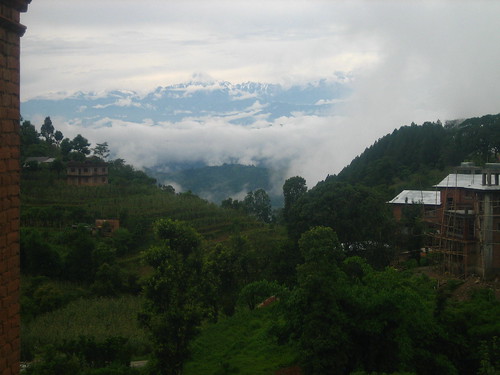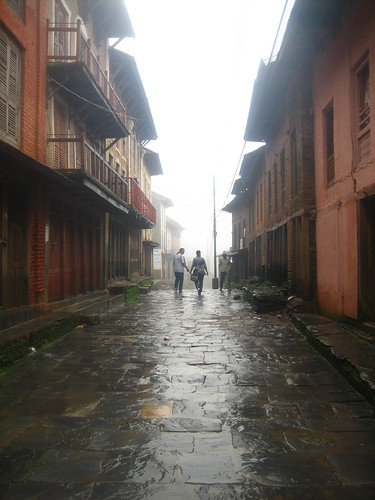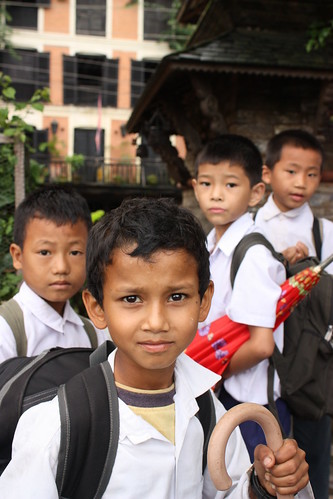Kathmandu – Paradise Lost
Monday, August 17th, 2009Before I came here, my image of Kathmandu was formed by seeing all those old hippy pictures from the 60s and 70s, long-haired folk in afghan coats, surrounded by the heavy fog of pot, maybe gently strumming a guitar as they hung out on the steps of Durbar Square, amazed at their good luck at finding such a blissed-out, chilled-out Shangri-La.
Thing is, it isn’t like that so much any more.
We’d purposely come back to Kathmandu with a week to spare before our flight out, knowing that we had to sort out a transit visa for India, and having read horror stories of just how long these took to get organised at the Indian Embassy. “Start queuing at 4am!” reads the Lonely Planet. Fellow bloggers recount tales of having to return many, many times just to get the right form. So a week should do it, we thought. Plus, after all that relaxing in Pokhara and Bandipur, surely we were ready for a bit of city living. Well maybe, but it turns out, just not this city. After such quiet havens, the traffic here seemed louder and more intense, the people far more numerous and crowding, the smells… well, the smells I could never describe in words. It was tough going coming back here.
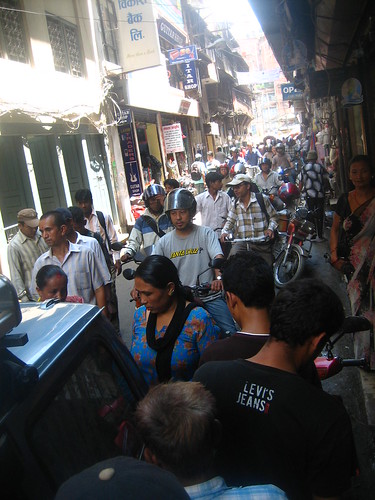
The first day was spent re-acclimatising, and making sure that we had everything ready for the great visa run. Concerned about the possibility of a 4am start, we asked around, and were somewhat mollified by people from the hotel telling us to get there at 8.30. As a compromise, we got in a taxi at 7.30, and were up at the Embassy for 7.45. Anticipating huge throngs of people, we were disconcerted to see we were the only people there. Reassuringly, this meant what we had hoped was true, was actually true – low season (monsoon) meant fewer foreign visitors trying to get visas. The doors opened at 8.30, so not too long to wait, and we spent these chatting to a couple of Australian NGOs waiting for visas also. When we were finally let in, a tout (some people pay agents in the region of 20 pounds just to do the queuing for them) swung in ahead of me and started pressing the ticket machine which churned out loads and loads of tickets. “I think you were 2 and 3, no?” she said to me. Back in bolshy mood, I snarled “NO, we were 1 and 2”, taking the relevant tickets out of her hand. We had to wait another hour (but on seats this time) before the windows slowly started to open. The tout woman STILL somehow managed to get in front of us, but not to worry – we were seen before long and with no hassle, we were told to come back at 4.30 that afternoon.
We filled the day by doing a walking tour of old Kathmandu. These winding streets, leading to hidden temples and courtyards, were the closest thing I’ve seen to Kathmandu as it used to be, and it was wonderful to see this ancient architecture and thousands upon thousands of carvings that elsewhere would be in a museum, above, say, a photocopying shop. However, the streets were still choked with traffic, and we were still hounded by touts and shopkeepers wherever we went. The tour led us to Durbar Square, the heart of Old Kathmandu, which is a number of interlinking squares dotted by hundreds of temples, including one that houses the Kumari Devi, Nepal’s living goddess. It was even busier than usual, as we’d chosen to visit on Krishna’s birthday, ensuring winding queues of women (only women) waiting to pay homage to Krishna.

It was an amazing sight (and site), but just not quite what I’d had in mind. It’s a World Heritage Site, so it was a bit of a shock to see just as many cars and motorbikes storming through the middle of it as on other roads – I’d, naively perhaps, assumed that it would be shut off to traffic. I enjoyed seeing it used as a market, as it would have always been used for this purpose, and rickshaws, ok, but bikes and cars that damage these wonderful buildings? No thanks. There wouldn’t have been so many vehicles back in the day, I guess.
To escape the city, the next day we took a taxi out in the Kathmandu valley to a town called Bakhtapur. This is an amazingly well preserved medieval town, and no traffic was allowed! We took the obligatory millions of photos, managing to shake off the tour guide touts telling them we came from “Cymru”, did they know that language? So we pretty much were able to wander round of our own accord. It was truly beautiful, and again, amazing to see these museum-worthy pieces being used as climbing frames or washing lines. Sad though that the children there are already learning to ask “you give me ten rupees?” – SOMEONE must have, once upon a time, or they wouldn’t ask. Makes me really sad.
The drive back to Kathmandu from Bakhtapur took about an hour, again through horrendous traffic – it was too hot to have the windows up, but open them just an inch and the choking black fumes from the buses and trucks surrounding us came flooding in. I was feeling quite queasy the rest of the day after that!
To get back on track, we spent lots of precious hours soaking up the greenery at the beautiful Garden of Dreams. Although situated right in the middle of tourist hub Thamel, seems to magically block out all the horns and pollution, just by walking through the gates. Attached to an old house, the formal gardens had originally fallen into rack and ruin, but have recently been brought back to their original, stunning glory. An amazing way to spend the day, just meandering and enjoying the peace. Even better, they have a fantastic restaurant here, and we came back on Saturday night to eat the best meal we’d had in Nepal, and generally be treated like kings, whilst looking out over the floodlit gardens.

And as for the rest of the days, we’ve spent them shopping, eating (one of the best things about Kathmandu is its restaurants – pretty much anything you fancy can be done), and enjoying some Everest Beers. The best drinking spot we’ve found is Rum Doodles, famous as being the home of the Everest Summiters’ Club, its walls are covered with signatures of legendary climbers such as Edmund Hillary, Tenzing Norgay Sherpa, Ang Dorje Sherpa, Rob Hall, and Jon Krakauer, along with cardboard footprints signed by people completing smaller treks, such as Everest Base Camp and the Annapurna Circuit (get me calling them “smaller” as if I’d been up to the top of Everest myself).
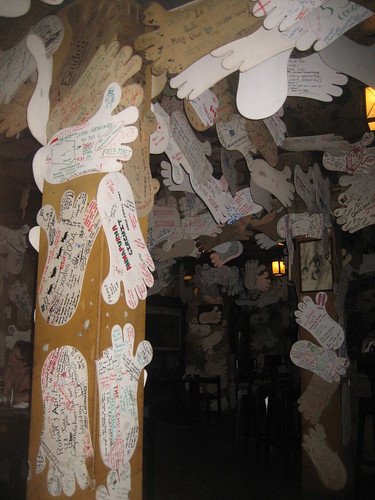
You can eat there free for life, if you’re part of the Summiters’ Club (and yes, they do verify it unfortunately, as I was considering making the claim myself and then moving to Kathmandu just so I could eat one of their Rum Doodles steaks every single day).
We’re ready now to move on to India and, if I’m honest, I won’t be sorry to leave Kathmandu. Nepal, yes, Kathmandu no. I’m sure it was a paradise once, and there are still glimpses of that paradise that occasionally strike you, but – and I’m sure the Western invasion has a massive part to play in this – now, sadly, it is very much Paradise Lost.


